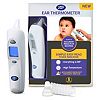Boots Pharmaceuticals Ear Thermometer
In order to buy non-prescription medicines you must be a registered user of our site as we are obliged to record your transaction history. We also ask that you complete our questionnaire so our pharmacy team can check that this product is suitable for you to buy.
Disabled or chronically sick people can claim VAT relief on purchases for personal or domestic use that are applicable to their disability or sickness.
 Product details
Product details
Boots Ear Thermometer
Accurate results within seconds
Simple easy read fever indicator with handy backlight for night time use
• Fever Alert
• Easy to use
• Backlight
• Stores last 10 readings
• Protective cap for hygiene
• C˚/F˚ measurement options
• Can also measure object and room temperature
This pack includes
• 1 x Boots Ear Thermometer
• 1 x Protective case
• 10 x Disposable caps
• 2 x 1.5v AAA batteries for operating thermometer
• 1 x Instruction Booklet
Why measure using an ear thermometer
Ear thermometers are widely used by healthcare professionals as a quick and easy, less intrusive alternative to a digital thermometer for measuring all but the very youngest children’s temperature. They provide accurate results without undue disturbance of the child, provided they are used correctly
Suitable for
From 6 months to adult
How to use
(For full details please read instruction manual enclosed)
Note: Remove plastic insulating strip from battery compartment before first use.
- Ensure a new protective cap is securely fitted over the thermometer tip before each use
- Switch the thermometer on, then pull the ear slightly up and backwards before gently inserting the thermometer tip into the ear and pressing the start button to begin the measurement.
- After approximately one second, an acoustic signal will sound and an easy read fever symbol plus the temperature will show in the display
- Once you have finished with the thermometer, switch off and return to protective case.
Hazards and Cautions
Temperature is not the only indication of illness. Consult a Doctor if you are concerned regarding your/your child's health, wether or not you have a high temperature.
Please read the instruction manual before use
Do not use outdoors or near any sources of heat
Do not drop thermometer or expose to any impacts









